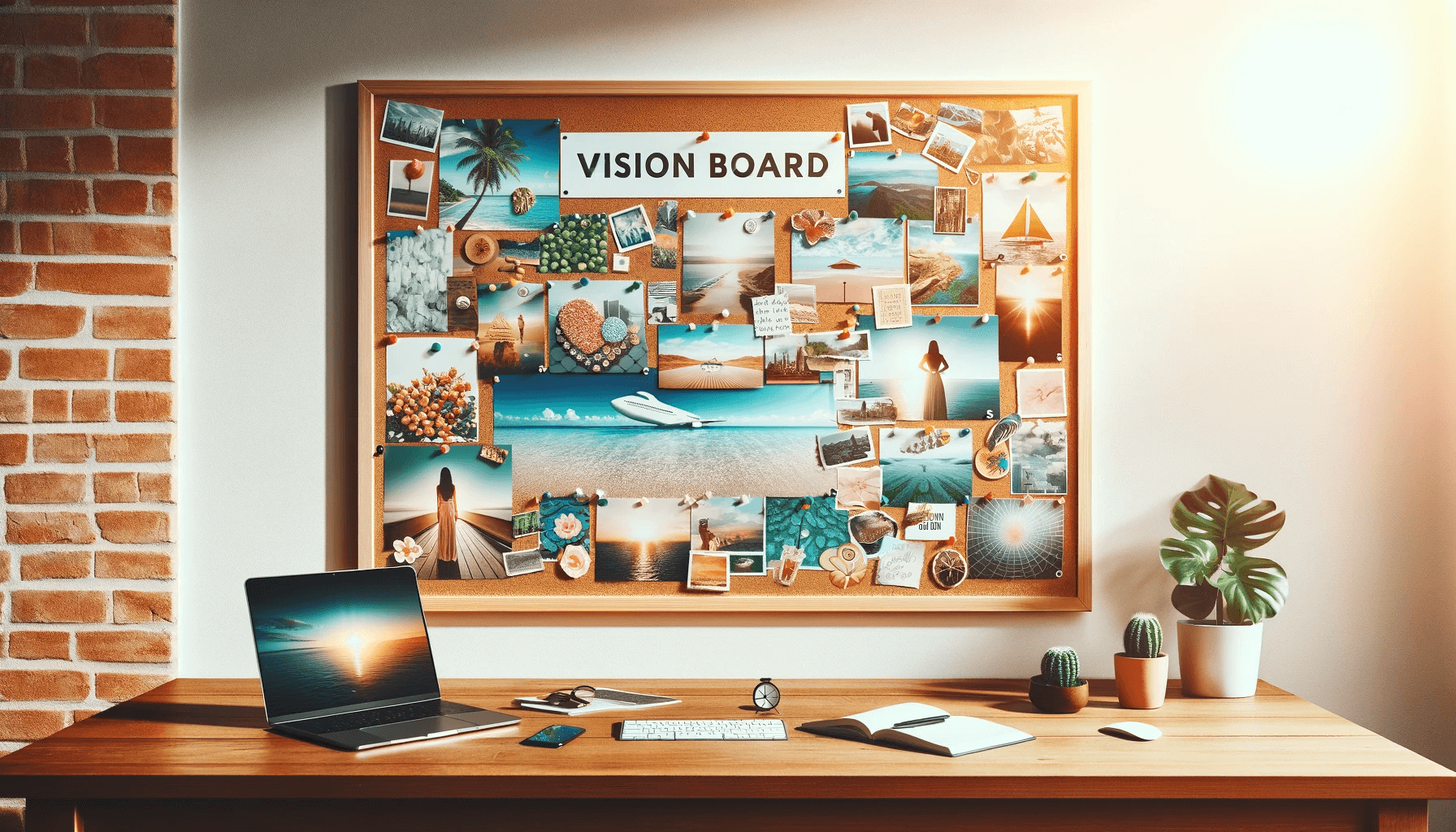Sponsor The Wealth Manifestation
Table of Contents
What is a vision board?
A vision board is a powerful tool that visually represents your goals and aspirations. It is a collage of images, words, and phrases that inspire and motivate you towards achieving your dreams. By creating a vision board, you manifest your desires and reinforce them in your subconscious mind. This practice has been used for centuries to help individuals clarify their vision and stay focused on their goals.
The power of visualization
Visualization is a technique used by many successful individuals to achieve their goals. By vividly imagining yourself already achieving what you desire, you send a clear message to your subconscious mind. This helps align your thoughts, emotions, and actions towards your desired outcome. When you visualize, you activate the creative powers of your mind and set in motion the process of turning your dreams into reality. A vision board is a tangible representation of your visualizations, constantly reminding you of what you are working towards.
Visualization has been proven to impact our ability to achieve our goals profoundly. Athletes often use visualization techniques to enhance their performance—successful entrepreneurs credit visualization as a critical factor in their success. By creating a vision board, you are harnessing the power of visualization to create the future you desire.
Benefits of creating a vision board
The benefits of creating a vision board are vast. Firstly, it helps you clarify what you truly want in life. Often, we have many desires and goals floating around in our minds, but we may need to take the time to articulate them clearly. By creating a vision board, you must identify and prioritize your goals. This clarity lets you focus on what truly matters to you.
Creating a vision board offers several benefits:
- Clarity for Your Goals: Assembling a vision board requires you to think and define your aspirations and desires, providing clear goals for your future.
- Motivation and Inspiration: Seeing a visual representation of your goals daily can be a powerful motivational tool, inspiring you to pursue them.
- Enhanced Focus: Having your goals visually represented in one place helps maintain focus on what’s important, reducing the likelihood of getting distracted by less important things.
- Positive Reinforcement: Vision boards can reinforce positive thinking by focusing your mind on what you want to achieve rather than what you want to avoid.
- Visualization Tool: The practice of visualization has been linked to improved performance and achievement. A vision board is a concrete way to engage in this practice, enabling you to envision and ‘experience’ your desired outcomes.
- Creativity Boost: Creating a vision board is a creative process that stimulates your imagination and opens your mind to new possibilities.
- Emotional Upliftment: Surrounding yourself with images and words that represent your highest aspirations can positively impact your emotions, keeping you in a more positive, uplifted state.
- Tracking Progress: Over time, you can add to or adjust your vision board, which can be a gratifying way to track your progress and growth.
- Law of Attraction: Some believe in the law of attraction, which states that we bring what we focus on into our lives. A vision board is a tool to help focus your thoughts and energy on your goals.
- Community and Sharing: Sharing your vision board can create a sense of community and accountability. It can also be a way to receive support and encouragement from friends, family, or peers.
Incorporating a vision board into your life can be a powerful step toward your desired future.
How to create a vision board
Creating a vision board is a fun and creative process. Here are the steps to get you started:
Choosing your goals and aspirations
Choosing goals and aspirations is a personal and introspective process. Here are some steps and tips to help you select meaningful and achievable goals:
- Reflect on Your Values and Passions: Start thinking about what truly matters. What are your core values? What activities or ideas make you feel excited and fulfilled? Aligning your goals with your values and passions ensures they are meaningful and motivating.
- Dream Big, But Be Realistic: Allow yourself to dream and think big, but also be realistic about what you can achieve. Setting overly ambitious goals leads to frustration, while attainable goals provide a sense of accomplishment and encourage further progress.
- Consider Different Life Areas: Consider various aspects of your life, such as career, education, personal growth, relationships, health, and hobbies. This holistic approach ensures a balanced set of goals.
- Short-Term and Long-Term Goals: Include both short-term and long-term goals. Short-term goals offer quick wins and keep you motivated, while long-term goals provide a broader vision to work toward.
- SMART Goals: Make your goals SMART – Specific, Measurable, Achievable, Relevant, and Time-bound. This framework helps in making your goals clearer and more attainable.
- Visualize the Outcome: For each goal, visualize what achieving it would look and feel like. This exercise can help clarify your desire and be a powerful motivator.
- Seek Inspiration: Look for inspiration in books, magazines, blogs, or from people who have achieved what you aspire to. This can spark ideas and help refine your goals.
- Be Flexible and Open to Change: Your goals may evolve, and that’s okay. Be open to revising your vision board as you grow, and your priorities shift.
- Include Personal Development Goals: Apart from external achievements, consider goals related to personal growth, like improving confidence, learning a new skill, or cultivating a positive mindset.
- Write Down Your Goals: Before creating your vision board, write down your goals. This helps organize your thoughts and gives you a clear list when making your board.
- Make It Emotional: Choose goals that stir an emotional response in you. Emotionally charged goals are more likely to keep you motivated and committed.
- Balance Between Challenge and Skill: Aim for goals that are challenging enough to excite you but not so difficult that they feel unattainable.
Remember, the most critical aspect of a vision board is that it resonates with you and represents what you truly want, not what others expect from you or what you think you should want.
Gathering materials for your vision board
Creating a vision board is an exciting and creative process. To start, you’ll need to gather some materials. Here’s a list of what you might need:
The base for Your Board:
- Poster board, corkboard, or canvas: Choose a size that fits your space and preference.
- Digital platform: Alternatively, you can use a digital format using apps or software like Pinterest, Canva, or Adobe Spark.
Images:
- Magazines: Collect a variety of magazines for a wide range of images.
- Printed images: Print pictures from the internet that align with your goals.
- Photographs: Personal photos that relate to your aspirations can be compelling.
Text Elements:
- Inspirational quotes: Find quotes that motivate you and align with your goals.
- Affirmations: Write or print affirmations that resonate with your aspirations.
- Typed or handwritten words: A single word can sometimes encapsulate a goal.
Decorative Elements:
- Stickers, washi tape, or decorative paper can add color and personality to your board.
- Ribbons, buttons, or other craft supplies: Use these to add texture and depth.
Writing and Cutting Tools:
- Markers, pens, or paint: For writing on your board or adding artistic touches.
- Scissors or a craft knife: For cutting out images and texts.
- Glue, tape, or pins: Depending on your base, you’ll need something to attach your items.
A Comfortable Workspace:
- Find a space where you can spread out your materials and work comfortably.
- Good lighting: Make sure the area is well-lit to see clearly.
A Planning Sheet:
- Before you start pasting or pinning, it’s helpful to lay out your images and elements on a separate sheet to plan the arrangement.
An Open Mind and Creativity:
- Remember, there’s no right or wrong way to create a vision board. It’s a personal and creative expression of your goals.
Take your time gathering materials that inspire you and reflect your aspirations. The process of creating the vision board should be enjoyable and inspiring in itself.
Organizing and arranging your vision board
Organizing and arranging your vision board is a crucial step in making it an effective tool for visualizing and achieving your goals. Here’s a guide to help you with this process:
Choose a Layout:
- Thematic: Organize your board by themes, such as career, personal growth, health, relationships, or travel.
- Segmented: Divide the board into sections, each representing a different aspect of your life.
- Central Focus: Place your most significant goal or aspiration in the center and arrange other elements around it.
- Free Form: Let your creativity flow and arrange images and words in a natural way.
Sort Your Materials:
- Before attaching anything to the board, flatly lay out all your images, quotes, and other elements.
- Group similar items together to understand how much space each theme or goal will need.
Visual Balance:
- Consider the colors, sizes, and textures of your materials. Try to distribute these elements evenly to create a visually appealing board.
- Balance doesn’t mean symmetry. It’s about creating a layout that’s pleasing to your eye.
Create a Focal Point:
- Your board should have a focal point that draws attention. This could be a remarkably inspiring image or a central goal.
- Place this element in a prominent position, such as the center or at the top of the board.
Layer and Overlap:
- Feel free to overlap images and texts for a dynamic look. This can also be a practical way to fit more onto your board.
- Layering can also symbolize the interconnectedness of your goals.
Leave Space for Growth:
- Consider leaving some empty space on your board for new goals, inspirations, or achievements you may want to add later.
Think About Accessibility:
- If there are elements you want to interact with regularly (like affirmations), place them where they are easily seen and reached.
Add Personal Touches:
- Personalize your board with your drawings, doodles, or handwriting to make it more meaningful.
Review and Adjust:
- Step back and look at your board from a distance. Make any necessary adjustments to improve the overall look or align with your goals.
Secure Everything in Place:
- Once you’re satisfied with the arrangement, start securing the items. Use glue, pins, or tape, depending on your board’s base.
Final Touches:
- Add any last-minute embellishments or decorative touches.
Remember, organizing and arranging your vision board should be enjoyable and reflective. It’s a visual representation of your dreams and aspirations, so take the time to make it inspiring and personal to you.
Using your vision board as a daily reminder
Using your vision board as a daily reminder is a powerful way to keep your goals and aspirations at the forefront of your mind. Here’s how you can effectively integrate it into your daily routine:
- Place It in a Visible Location: Position your vision board somewhere you’ll see it often. This could be in your bedroom, home office, or even a digital version as your computer’s wallpaper. The key is frequent visibility.
- Make It Part of Your Morning Routine: Spend a few minutes each morning looking at your vision board. Use this time to focus on your goals and visualize achieving them. This sets a positive tone for the day.
- Reflect and Meditate: Allocate time to reflect on your board, perhaps during meditation or quiet time. Concentrate on how achieving these goals will feel, and affirm your ability to realize them.
- Use It as a Motivation Tool: Whenever you feel your motivation waning, take a moment to look at your vision board. Remember why these goals matter to you and the steps you need to take to achieve them.
- Review Your Goals Regularly: Reviewing the items on your vision board helps keep your goals fresh. It also allows you to recognize and celebrate any progress you’ve made.
- Incorporate Affirmations: If you’ve included affirmations on your board, say them out loud daily. This reinforces a positive mindset and aligns your thoughts with your goals.
- Connect Emotionally: When you look at your board, connect emotionally with the images and words. Emotional, solid connections reinforce your commitment and desire to achieve these goals.
- Update Your Board as Needed: As you grow and evolve, so will your aspirations. Feel free to update your vision board to reflect new goals or achievements.
- Share Your Vision: Occasionally, share your goals with a trusted friend or family member. Talking about your vision board can provide additional motivation and new insights or ideas.
- Integrate into Goal-Setting Sessions: If you regularly set aside time for goal-setting or planning, use your vision board as a guide. It can help keep your objectives aligned with your broader aspirations.
- Visualize Success: Practice visualizing the successful achievement of your goals as you look at your vision board. This mental rehearsal can enhance your drive and belief in your ability to succeed.
- Stay Flexible and Positive: Remember that the journey to achieving your goals might have ups and downs. Stay flexible in your approach and maintain a positive attitude, using your vision board as a steady reminder of where you’re headed.
By making your vision board a part of your daily life, you keep your dreams and aspirations alive, providing continuous inspiration and motivation.
Tracking your progress and adjusting your vision board
Tracking progress and adjusting your vision board over time is essential to the goal-achieving process. Here are some strategies to do this effectively:
Regular Check-Ins:
- Schedule regular intervals (monthly, quarterly, etc.) to review your progress. This helps track what you have achieved and what still needs attention.
- Reflect on each goal: What steps have you taken towards it? What successes have you had? What challenges have you faced?
Document Your Journey:
- Keep a journal or a digital document where you note your progress, thoughts, and feelings about your journey toward your goals.
- Consider taking photos or screenshots of your achievements, no matter how small. This visual record can be a powerful motivator.
Celebrate Milestones:
- Acknowledge and celebrate when you reach a milestone, even a small one. This reinforces positive behavior and keeps you motivated.
- You might even add something to your vision board to commemorate these achievements.
Stay Flexible and Adapt:
- If certain goals no longer resonate with you, don’t be afraid to remove them from your board. Our aspirations can change over time, and your vision board should reflect that.
- If you encounter unforeseen obstacles, adjust your strategies and timelines accordingly. Be flexible in how you approach your goals.
Update Your Board:
- As you achieve your goals, update your board to reflect these changes. This might mean replacing achieved goals with new ones.
- Consider rearranging or updating the board’s layout or design to keep it fresh and inspiring.
Reflect on What’s Not Working:
- If you find that some goals are consistently unmet, take time to understand why. Is it a need for more resources, motivation, or clarity? Adjust your approach or the goal itself as needed.
Seek Feedback:
- Sometimes, getting an outside perspective can be helpful. Share your progress and vision board with someone you trust and get their input.
Visualize Continuously:
- Keep using your vision board as a tool for visualization. Regularly imagining yourself achieving your goals can help maintain your focus and motivation.
Align with Your Values and Growth:
- Ensure that your vision board continues to align with your core values and personal growth. As you evolve, so should your goals and aspirations.
Reaffirm Your Commitment:
- Regularly remind yourself why these goals are essential to you. This reaffirmation can help you stay committed and focused.
Remember, a vision board is not just a set-it-and-forget-it tool. It’s a dynamic, evolving representation of your aspirations and a reflection of your journey. Regularly updating and adjusting your vision board can keep it relevant and inspiring, helping you stay on track to achieve your dreams.
Sharing your vision board with others
Sharing your vision board with others can be highly beneficial in several ways:
- Accountability: When you share your goals and aspirations with others, it creates a sense of accountability. Friends or family who are aware of your goals may check in on your progress, providing an extra layer of motivation to pursue them.
- Feedback and Advice: Others can offer valuable feedback or advice that might help you refine your goals or find more effective ways to achieve them. They might have experiences or insights that you still need to consider.
- Support and Encouragement: Sharing your vision board can open up a support system. Knowing that others are rooting for your success can be a significant emotional and mental boost, especially during challenging times.
- Networking Opportunities: Sometimes, the people you share your vision board with may have or know someone who has the resources, connections, or skills that can help you achieve your goals. This networking aspect can be crucial in turning your visions into reality.
- Collaborative Opportunities: Sharing your vision board might reveal common goals or interests with others, leading to potential collaborations. Working together towards a shared goal can be more effective and enjoyable.
- Inspiration for Others: Your vision board might inspire others to create their own or to pursue their goals more actively. It’s a way to influence those around you positively.
- Increased Commitment: Articulating your goals to others can reinforce your commitment to them. Explaining and discussing your vision can deepen your understanding and dedication to these goals.
- Emotional Connection: Sharing your aspirations can create deeper emotional connections with others. It allows people to understand your ambitions and desires more personally.
- Diverse Perspectives: Others might offer different perspectives on your goals that could be beneficial. They may see possibilities or potential challenges you have yet to notice haven’t.
- Celebrating Milestones: As you progress towards your goals, sharing these milestones with others who are aware of your vision board can lead to shared celebrations, making the journey more rewarding.
However, being it’s selective about whom you share your vision board with is also important. Choose people who are supportive, positive, and genuinely interested in your well-being and success.
Maintaining motivation and staying focused
Maintaining motivation and staying focused can be challenging, but there are several effective strategies you can use:
- Set Clear Goals: Clearly defined goals give you a roadmap to follow. Break them into smaller, manageable tasks to avoid feeling overwhelmed and provide a sense of accomplishment as you complete each step.
- Create a Routine: Establish a daily or weekly routine incorporating time to work towards your goals. Consistency is critical to maintaining focus and building momentum.
- Prioritize Tasks: Identify the most important tasks that will have the most significant impact on your goals. Focus on completing these tasks first to ensure your energy is used effectively.
- Use a Planner or To-Do List: Keeping a planner or to-do list can help you organize tasks and keep track of your progress. Crossing off completed tasks can also provide a sense of achievement.
- Eliminate Distractions: Identify what distracts you and find ways to minimize these distractions. This might involve creating a dedicated workspace, turning off notifications on your phone, or setting specific times for checking emails and social media.
- Practice Self-Care: Regular exercise, adequate sleep, and healthy eating can significantly impact your energy levels and concentration. Don’t neglect your physical and mental health.
- Stay Inspired: Regularly remind yourself why your goals are important. This could be through a vision board, motivational quotes, or revisiting the reasons you set these goals in the first place.
- Seek Support: Surround yourself with supportive people who encourage your efforts. This can include friends, family, mentors, or even online communities.
- Reward Yourself: Set up a system of rewards for reaching milestones. This can help maintain your enthusiasm and give you something to look forward to.
- Reflect and Adjust: Regularly reflect on your progress and be willing to adjust your strategies if something isn’t working. Flexibility is essential in maintaining long-term motivation.
- Learn from Setbacks: Instead of getting discouraged by setbacks, try to view them as learning opportunities. Analyze what went wrong and how you can avoid similar issues in the future.
- Visualize Success: Spend time visualizing and achieving your goals. This positive mental rehearsal can boost your confidence and motivation.
Maintaining motivation is about more than just being 100% focused all the time. It’s normal to have ups and downs. The key is to keep moving forward, even if it’s just small steps on some days.
Success stories of individuals who used vision boards
Vision boards have been used by many individuals who attribute part of their success to this tool. Here are a few notable success stories:
- Oprah Winfrey: Oprah has spoken about the power of visualization and positive thinking in achieving her goals. She has used vision boards to help manifest her aspirations, emphasizing how they helped her clarify and focus on her objectives.
- Jim Carrey: One of the most famous stories is that of actor Jim Carrey, who wrote himself a check for $10 million for “acting services rendered,” dated it for Thanksgiving 1995, and kept it in his wallet. In 1994, he learned he would earn that exact amount for his role in “Dumb and Dumber.” Carrey has credited visualization and belief in his goals for his success.
- Ellen DeGeneres: Ellen reportedly used a vision board to manifest her role on the cover of “O, The Oprah Magazine.” She shared her desire to be on the cover with her audience and used a vision board to help make it happen, which it eventually did in 2009.
- Sarah Centrella: Author of “Hustle Believe Receive,” Centrella credits vision boards for turning her life around after a difficult divorce. She used them to focus on her goals, which included becoming a published author, traveling the world, and meeting her sports heroes – all of which she achieved.
- John Assaraf: One of the contributors to “The Secret,” John Assaraf, shared a powerful story about how a vision board helped him realize a long-held dream. Years after creating a vision board with a picture of his dream house, he realized he had bought the exact house he had pinned years earlier.
- Terri Savelle Foy: As a motivational speaker, Foy frequently shares how vision boards helped her achieve personal and professional goals, including becoming a best-selling author and achieving her fitness goals.
- Lilly Singh: The popular YouTuber and talk show host has spoken about using vision boards to help her focus on her goals, including becoming an actress and author.
These stories illustrate how vision boards can be a powerful tool in focusing one’s thoughts and energies toward achieving goals. However, it’s important to note that they are most effective when combined with hard work, determination, and a clear action plan.
Conclusion
Creating a vision board is a powerful tool to help you design your future and achieve your goals. By visualizing and reinforcing your desires in your subconscious mind, you align your thoughts, emotions, and actions towards your desired outcome. The benefits of creating a vision board include gaining clarity, staying motivated, and staying focused on your goals.
So, take time to reflect on what you truly want in life, gather the materials, and create your vision board. Surround yourself with images, words, and phrases that inspire and motivate you. Display your vision board in a prominent place and make it a daily habit to visualize your desired outcomes. Stay committed, track your progress, and adjust your vision board. Share your goals with others and seek their support and accountability. And most importantly, maintain your motivation and focus on your dreams.
You have the power to design your future. Start today by creating a vision board that reflects your goals and aspirations. The journey towards achieving your dreams begins with a single step.






